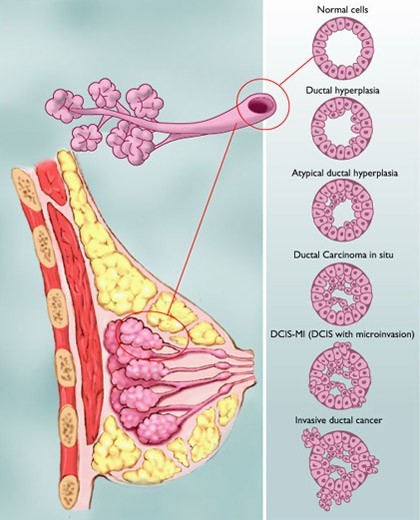“Colletti was diagnosed with ductal carcinoma in situ (DCIS), also known as Stage 0 breast cancer, in April 2014. But rather than immediately having surgery, Colletti opted for an alternative—something called active surveillance.
Thanks to advances in genomic testing and deeper insights into the biology of different kinds of breast cancer, doctors are learning that the one-size-fits-all approach isn’t working. They’re also learning that every woman brings with her a unique profile of biological risk—as well as a unique appetite for risk. That means that while some women require urgent and aggressive treatment, there are many who can slow down and take a more sparing approach.
Colletti was referred to Dr. Shelley Hwang, chief of breast surgery at Duke Medical Center in North Carolina, who is one of the growing number of breast cancer experts in the U.S. who partner with patients on active surveillance for patients with low-grade DCIS. With this watch-and-wait approach, patients forgo traditional treatments like radiation and surgery and instead do screenings—mammograms, MRIa—every six months, sometimes in tandem with hormone therapy.
This represents a paradigm shift in breast cancer treatment, with a small but influential chorus of experts calling for a major shift in the way doctors treat—and talk about—the disease, from the first few millimeters of suspicious-looking cells in milk ducts to the invasive masses found outside of them…
That’s making the tough conversations between a woman and her cancer doctor ever harder, but it also stands to make them more fruitful. Because as good as we have gotten at finding breast cancer—and we’ve gotten very good—new data suggests there may be better ways to treat some breast cancers, particularly those at the early stages. Evidence is mounting that aggressive treatments, designed in earnest to save women’s lives, can have unforeseen and sometimes devastating consequences.
It’s the multiple follow-up surgeries after a mastectomy and the subsequent infections; the radiation that doesn’t always improve survival and the cancer risk that can come with too much of it; the sometimes unnecessary chemotherapy and its life-sapping side effects. For some in the field, that collateral damage is getting harder and harder to justify…”



